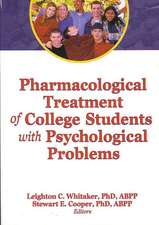Applied Clinical Pharmacokinetics and Pharmacodynamics of Psychopharmacological Agents
Editat de Michael W. Jann, Scott R. Penzak, Lawrence J. Cohenen Limba Engleză Hardback – 13 mar 2016
Thefirst section provides the foundational principles of these drugs. Mathematicalmodeling of parameters that affect their entryto,and exit from, the centralnervous system (CNS) compartment are presented on an individual basis and thenapplied to target populations with specific disease states. Methods andcharacteristics that inform the transfer of these drugs from the laboratorybench to use in patient care are discussed, including imaging techniques,genetics and physiological barriers, such as the blood-brain barrier. The secondsection describes the characteristics of specific agents,nominally arrangedintodifferent therapeutic categories and with reference crossover use indifferent disease states. The pharmacologic characteristics of different drugformulations are explored in the context of their ability to improve patientadherence. The third section focuses on drug-drug interactions.Psychotropic medicationsfrom different categories are frequently prescribed together,or alongsidemedications used to treat comorbid conditions, and the information provided isdirectly relevant to the clinic, as a result.
Theclinical application of pharmacokinetics and pharmacodynamics of CNS agents hasmade significant progress over the past 50 years and new information is reportedby numerous publications in psychiatry, neurology, and pharmacology.Ourunderstanding of the interrelationship between these medications, receptors,drug transporters, as well as techniques for measurement and monitoring theirinteractions,isfrequently updated. However, with information presented on ahost of different platforms, and in different formats, obtaining the fullpicture can be difficult. This title aims to collate this information into asingle source that can be easily interpreted and applied towards patient careby the clinical practitioner, and act as a reference for all others who have aninterest in psychopharmacological agents.
| Toate formatele și edițiile | Preț | Express |
|---|---|---|
| Paperback (1) | 803.11 lei 38-44 zile | |
| Springer International Publishing – 24 apr 2018 | 803.11 lei 38-44 zile | |
| Hardback (1) | 1320.06 lei 3-5 săpt. | |
| Springer International Publishing – 13 mar 2016 | 1320.06 lei 3-5 săpt. |
Preț: 1320.06 lei
Preț vechi: 1389.54 lei
-5% Nou
Puncte Express: 1980
Preț estimativ în valută:
252.62€ • 274.31$ • 212.20£
252.62€ • 274.31$ • 212.20£
Carte disponibilă
Livrare economică 02-16 aprilie
Preluare comenzi: 021 569.72.76
Specificații
ISBN-13: 9783319278810
ISBN-10: 3319278819
Pagini: 607
Ilustrații: XIV, 601 p. 100 illus., 50 illus. in color.
Dimensiuni: 155 x 235 x 39 mm
Greutate: 1.32 kg
Ediția:1st ed. 2016
Editura: Springer International Publishing
Colecția Adis
Locul publicării:Cham, Switzerland
ISBN-10: 3319278819
Pagini: 607
Ilustrații: XIV, 601 p. 100 illus., 50 illus. in color.
Dimensiuni: 155 x 235 x 39 mm
Greutate: 1.32 kg
Ediția:1st ed. 2016
Editura: Springer International Publishing
Colecția Adis
Locul publicării:Cham, Switzerland
Public țintă
Professional/practitionerCuprins
Section 1. General Pharmacokinetic and Pharmacodynamic Principles ofPsychopharmacological Agents.- 1. Pharmacokinetic Properties.- 2. PharmacodynamicProperties.- 3. PET Scan and Other Biomarkers.- 4. PopulationPharmacokinetics.- 5. Drug Transporters (esp. Blood Brain Barrier).- 6. Pharmacogenomics.-Section 2. Clinical Pharmacokinetics and Pharmacodynamics ofPsychopharmacological Drug Classes.- 7. Antipsychotics – oral typical agents,oral atypical agents, and long-acting injectable (LAI) antipsychotics.- 8. MoodStabilizers.- 9. Antidepressants – tricyclics, selective serotonergic reuptakeinhibitors, serotonergic noradrenergic reuptake inhibitors, monoamine oxidaseinhibitors, and other antidepressants.- 10. Benzodiazepines and Other SedativeHypnotics/Anxiolytics.- 11. Opioid Analgesics.- 12. Stimulants and OtherNon-Stimulants for ADHD.- 13. Cholinesterase Inhibitors and Other AntidementaAgents.- 14. Anti-Addiction Agents.- 15. Anesthetics.- Section 3. ClinicallySignificant Drug Interactions With Psychopharmacological Agents.- 16.Antipsychotics.- 17. Mood Stabilizers.- 18. Antidepressants.- 19.Benzodiazepines and Other Sedative Hypnotics/Anxiolytics.- 20. OpioidAnalgesics.- 21. Stimulants and Other Non-Stimulants for ADHD.- 22. CholinesteraseInhibitors and Other Antidementa Agents.- 23. Anti-Addiction Agents.- 24.Anesthetics.
Notă biografică
MichaelW. Jann, Pharm.D., FCP, FCCP is Professor and Chair for the Department ofPharmacotherapy at the University of North Texas System College of Pharmacy(UNTSCP) located at the UNT Health Sciences Center (UNTHSC). Professor Jannreceived his Doctor of Pharmacy degree from the University of Southern Californiaand post-doctoral training in mental health pharmacy practice at the Universityof Tennessee Memphis College of Pharmacy. He has published over 230 peer-reviewarticles, abstracts, and book chapters and served as a primary investigator fornumerous clinical trials in psychopharmacology. Professor Jann serves on theeditorial boards of six peer-review scientific journals including CNS Drugs,Molecular Diagnostics and Therapeutics, The Scientific World Journal –Pharmacology Section, The Consultant Pharmacist, Journal of ClinicalPharmacology, and Journal of Pharmacy Practice.
Scott R. Penzak, Pharm.D., FCP, is Professor andVice Chair for the Department of Pharmacotherapy at the University of NorthTexas System College of Pharmacy (UNTSCP) located at the UNT Health SciencesCenter (UNTHSC). Professor Penzak received his Doctor of Pharmacy degree fromWayne State University and completed his post-doctoral training in infectiousdiseases at the University of Arkansas for Medical Science (UAMS). Prior toUNTSCP, he was the Director of the Clinical Pharmacokinetics Laboratory at the NIH. He has published over 150 peer-review articles,abstracts, and book chapters, and served as a principal investigator onnumerous pharmacokinetic and pharmacogeneticstudies. Professor Penzak serves onthe editorial boards of three peer-review scientific journals including Journalof Clinical Pharmacology, Pharmacotherapy, and the International Journal ofPharmacokinetics.
Lawrence J. Cohen, PharmD, BCPP, FASHP, FCCP,FCP, FNAP is currently Professor of Pharmacotherapy at the University of NorthTexas System College of Pharmacy. Examples of Professor Cohen’s previousservice include, Global Director of CNS Research for Kendle International,Director of the Office of Clinical Trials for University of Cincinnati, andDirector of Pharmaceutical Services for the Oklahoma Department of MentalHealth and Substance Abuse Services. Professor Cohen received his Doctor of Pharmacydegree and post-doctoral training in psychiatric pharmacy from University ofSouthern California School of Pharmacy. Professor Cohen has been a BoardCertified Psychiatry Pharmacist since the specialty was recognized. His relevant service on Editorial Boards include CurrentPsychiatry, Innovations in Clinical Neuroscience, Primary Care Companion of theJournal of Clinical Psychiatry, Drug Benefit Trends, Journal of the AmericanMedical Directors Association, CNS News and Pharmacy Practice News.
Scott R. Penzak, Pharm.D., FCP, is Professor andVice Chair for the Department of Pharmacotherapy at the University of NorthTexas System College of Pharmacy (UNTSCP) located at the UNT Health SciencesCenter (UNTHSC). Professor Penzak received his Doctor of Pharmacy degree fromWayne State University and completed his post-doctoral training in infectiousdiseases at the University of Arkansas for Medical Science (UAMS). Prior toUNTSCP, he was the Director of the Clinical Pharmacokinetics Laboratory at the NIH. He has published over 150 peer-review articles,abstracts, and book chapters, and served as a principal investigator onnumerous pharmacokinetic and pharmacogeneticstudies. Professor Penzak serves onthe editorial boards of three peer-review scientific journals including Journalof Clinical Pharmacology, Pharmacotherapy, and the International Journal ofPharmacokinetics.
Lawrence J. Cohen, PharmD, BCPP, FASHP, FCCP,FCP, FNAP is currently Professor of Pharmacotherapy at the University of NorthTexas System College of Pharmacy. Examples of Professor Cohen’s previousservice include, Global Director of CNS Research for Kendle International,Director of the Office of Clinical Trials for University of Cincinnati, andDirector of Pharmaceutical Services for the Oklahoma Department of MentalHealth and Substance Abuse Services. Professor Cohen received his Doctor of Pharmacydegree and post-doctoral training in psychiatric pharmacy from University ofSouthern California School of Pharmacy. Professor Cohen has been a BoardCertified Psychiatry Pharmacist since the specialty was recognized. His relevant service on Editorial Boards include CurrentPsychiatry, Innovations in Clinical Neuroscience, Primary Care Companion of theJournal of Clinical Psychiatry, Drug Benefit Trends, Journal of the AmericanMedical Directors Association, CNS News and Pharmacy Practice News.
Textul de pe ultima copertă
Thisbook is a comprehensive resource on psychotropic medications, detailing thelatest methods for defining their characteristics, their use in differentpatient populations, and drug-drug interactions; an important collection ofinformation forclinicians, students, researchers, and members of thepharmaceutical industry alike.
Thefirst section provides the foundational principles of these drugs. Mathematicalmodeling of parameters that affect their entryto,and exit from, the centralnervous system (CNS) compartment are presented on an individual basis and thenapplied to target populations with specific disease states. Methods andcharacteristics that inform the transfer of these drugs from the laboratorybench to use in patient care are discussed, including imaging techniques,genetics and physiological barriers, such as the blood-brain barrier. The secondsection describes the characteristics of specific agents,nominally arrangedintodifferent therapeutic categories and with reference crossover use indifferent disease states. The pharmacologic characteristics of different drugformulations are explored in the context of their ability to improve patientadherence. The third section focuses on drug-drug interactions.Psychotropic medicationsfrom different categories are frequently prescribed together,or alongsidemedications used to treat comorbid conditions, and the information provided isdirectly relevant to the clinic, as a result.
Theclinical application of pharmacokinetics and pharmacodynamics of CNS agents hasmade significant progress over the past 50 years and new information is reportedby numerous publications in psychiatry, neurology, and pharmacology.Ourunderstanding of the interrelationship between these medications, receptors,drug transporters, as well as techniques for measurement and monitoring theirinteractions,isfrequently updated. However, with information presented on ahost of different platforms, and in different formats, obtaining the fullpicture can be difficult. This title aims to collate this information into asingle source that can be easily interpreted and applied towards patient careby the clinical practitioner, and act as a reference for all others who have aninterest in psychopharmacological agents.
Thefirst section provides the foundational principles of these drugs. Mathematicalmodeling of parameters that affect their entryto,and exit from, the centralnervous system (CNS) compartment are presented on an individual basis and thenapplied to target populations with specific disease states. Methods andcharacteristics that inform the transfer of these drugs from the laboratorybench to use in patient care are discussed, including imaging techniques,genetics and physiological barriers, such as the blood-brain barrier. The secondsection describes the characteristics of specific agents,nominally arrangedintodifferent therapeutic categories and with reference crossover use indifferent disease states. The pharmacologic characteristics of different drugformulations are explored in the context of their ability to improve patientadherence. The third section focuses on drug-drug interactions.Psychotropic medicationsfrom different categories are frequently prescribed together,or alongsidemedications used to treat comorbid conditions, and the information provided isdirectly relevant to the clinic, as a result.
Theclinical application of pharmacokinetics and pharmacodynamics of CNS agents hasmade significant progress over the past 50 years and new information is reportedby numerous publications in psychiatry, neurology, and pharmacology.Ourunderstanding of the interrelationship between these medications, receptors,drug transporters, as well as techniques for measurement and monitoring theirinteractions,isfrequently updated. However, with information presented on ahost of different platforms, and in different formats, obtaining the fullpicture can be difficult. This title aims to collate this information into asingle source that can be easily interpreted and applied towards patient careby the clinical practitioner, and act as a reference for all others who have aninterest in psychopharmacological agents.
Caracteristici
Provides new information on pharmacokinetics and pharmacodynamics of psychopharmacological agents
Discusses interplay between various psychotropic medications and transporter protein in the CNS
Presented as a unique and user-friendly source ?
Discusses interplay between various psychotropic medications and transporter protein in the CNS
Presented as a unique and user-friendly source ?

















